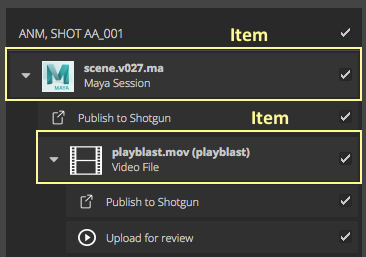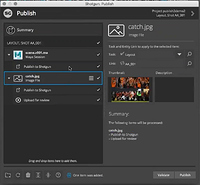Roy discovered some similarities with Pyblish in this video from Shotgun. Some interesting bits to learn and possibly improve from.
Overview
publish2 is the name of Shotgun’s publisher. It shares a few ideas with Pyblish, like Collection, Validation and Integration but have a few interesting differences that I wanted to capture and discuss.
| Difference | pyblish | publish2 |
|---|---|---|
| Plug-ins | One per file | -||- |
| Output | Called instance
|
Called item
|
| CVEI | Collect, Validate, Extract, Integrate | Collect, Accept, Validate, Publish, Finalize |
| Order | Dynamically arranges the order in which plug-ins are called |
Statically declares an order in an external .yml file. |
| Log | Terminal is where each plug-in emits debug text | Called Logging View, and they’ve got a Copy to Clipboard which is very handy! |
| Dependencies | Pyblish runs in any host accessible with Python 2.7-3.7 with QML | Presumably requires PySide2 from within the host, similar to Pyblish Lite |
| Icons | Each item can have an icon, indicating what it is like a playblast or Maya scene file. |
|
| Commandline | Implemented | |
| Standalone | Implemented | -||- |
| Messages | Printed at the bottom of each UI | -||- |
| Families | Determines which plug-ins to run, relative what’s in the scene | Called type
|
| UI Layout |
Two-columns, one for instances the other for plug-ins |
Hierarchical, plug-ins parented under each item
|
| UI Comment | Overlay, toggled | Sidepanel, persistent |
| UI Dragndrop | Include ad-hoc external files in any publish | |
| UI Thumbnail | In addition to a comment, also add an image |
Screenshots
Order
Here’s how you arrange which plug-ins to run and in which order.
tk-multi-publish2.yml
settings-tk-multi-publish2.maya.shot_step:
collector: "{self}/collector.py:{engine}/tk-multi-publish2/basic/collector.py"
Work Template: maya_shot_work
publish_plugins:
- name: Publish to Shotgun
hook: "{self}/publish_file.py"
settings: {}
- name: Upload for review
hook: "{self}/upload_version.py"
settings: {}
- name: Begin file versioning
hook: "{engine}/tk-multi-publish2/basic/start_version_control.py"
settings: {}
help_url: *help_ur
location: "@apps.tk-multi-publish2.location"
A few interesting tidbits.
-
collectorPresumably not a plug-in like the others -
Work TemplateUnclear of what this is, but presumably something you can access from within a plug-in to make decisions, e.g. whether you’re publishing from Animation or Modeling. -
hookPresumably what’s calledpluginelsewhere, and is the actual plug-in file. Possibly it’splugin+ metadata, like name and “settings” -
settingsPresumably things that can be accessed from within a plug-in to make decisions -
help_urlUnclear whether this applies to all plug-ins somehow, or whether it’s a meta-level help url for general help about this particular YML setup.
It’s unclear whether you define this once for all of your Shotgun integration, or per shot. The one above appears to reside in an internal Shotgun directory.
/publish2demo2/config/env/includes/settings
Hierarchical Items
Unlike Pyblish, publish2 can visually nest items, where plug-ins are further nested under each item.

Presumably these are evaluated from inside-out, such that the parent is published after its children, like a sort of dependency chain. Pyblish can nest and perform logic on nested instances, but it isn’t visible in the UIs.
Plug-in Help Text
Plug-ins in publish2, like Pyblish, are individual classes.
class ValidateSomething(...):
pass
In Pyblish, the doc-string is used as help-text for both programmer and artist.
class ValidateSomething(...):
"""This validates someting"""
In publish2 the same is true, but implemented as a @property
class ValidateSomething(...):
@property
def description(self):
return "This validates something"
Summary
In interesting take, for sure. Would be interesting to hear from the developers about tradeoffs made relative Pyblish more dynamic nature. The idea of declaring plug-ins from a single location is something that’s been requested for Pyblish as well; having plug-ins appear and disappear dynamically can be both a blessing and a curse, and it would be interesting to explore a similar method as an alternative for working with Pyblish.
Visually, I like the idea of having a properties page on the side. Ours is hidden within a tab which makes it a little more scary. We’re saving space, and make the UI fit for a vertical screen like a phone, but what for? We could definitely use some more horizontal space.


